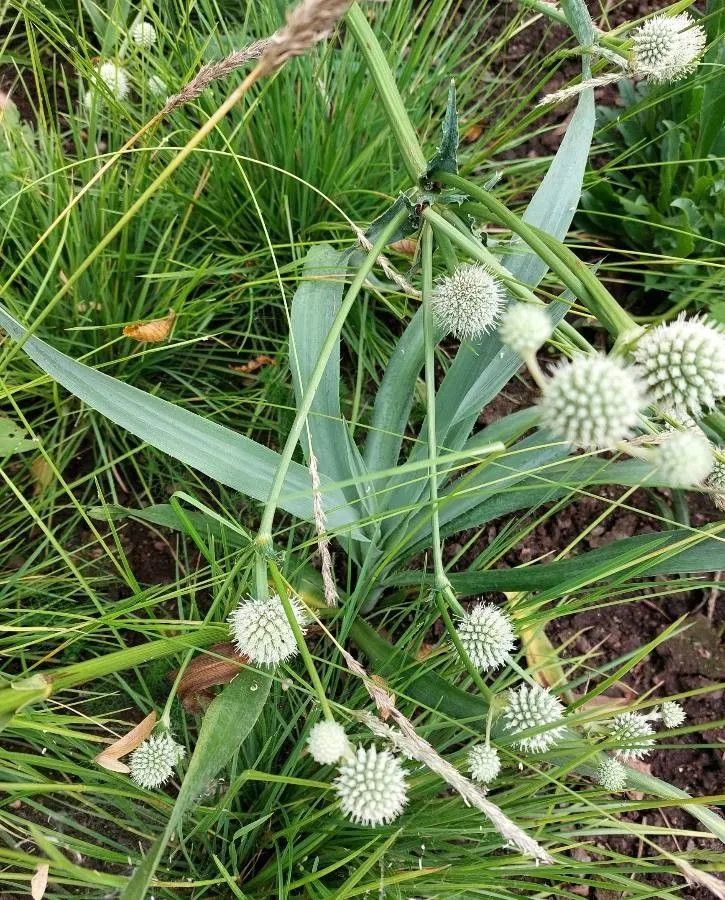
Author: Michx.
Bibliography: Fl. Bor.-Amer. 1: 164 (1803)
Year: 1803
Status: accepted
Rank: species
Genus: Eryngium
Vegetable: False
Observations: C. & E. U.S.A.
Rattlesnake-master, scientifically referred to as Eryngium yuccifolium, is a unique and visually striking plant belonging to the Apiaceae family. First documented in 1803 by Michx. in “Fl. Bor.-Amer. 1: 164,” this perennial herb is native to the central and eastern regions of the United States and is renowned for its distinctive appearance and ecological significance.
Characterized by yucca-like leaves, Eryngium yuccifolium thrives in prairies, savannas, and open woodlands, where it typically reaches heights of 2 to 5 feet. The plant’s basal leaves are long, rigid, and sword-shaped, with margins often edged with sharp, bristly teeth. These leaves can grow up to 3 feet in length, forming a rosette that provides a formidable architectural presence in any landscape.
Come summer, Rattlesnake-master produces a profusion of unique, globular flower heads. These inflorescences, which bloom from mid-summer to early fall, are composed of numerous small, greenish-white flowers clustered together, giving the appearance of round, spiny balls. Each individual flower is adorned with bristly bracts, further lending the plant its distinctive look. The flower heads are held aloft on tall, unbranched stems, creating a striking contrast against its own evergreen foliage and any accompanying plant species.
Ecologically, Eryngium yuccifolium plays a pivotal role in its native habitats. Its flowers are a magnet for a wide array of pollinators, including bees, wasps, and butterflies, making it an important component of the pollination network. Moreover, its robust root system helps stabilize soils, a critical function in maintaining the health and integrity of prairie ecosystems.
The common name “Rattlesnake-master” harkens back to folklore and medicinal uses by Native American tribes, who believed the plant could be used to treat rattlesnake bites. While contemporary herbalists utilize the plant for its potential medicinal properties, these traditional uses highlight the plant’s long-standing presence and significance in human culture.
Rattlesnake-master is also valued for its tolerance to drought and poor soil conditions, making it an excellent choice for gardeners and landscapers aiming to cultivate native plant gardens or xeriscapes. Its structural form and textural contrast make it a companion plant for ornamental grasses and other prairie species, offering visual interest and ecological benefits in designed landscapes.
Overall, Eryngium yuccifolium stands as a testament to the resilience and beauty of native plant species in the central and eastern United States, embodying both ecological and historical richness in its unassuming form.
Eng: button eryngo, button snakeroot, rattlesnake-master
Swe: skallerormsmartorn
Deu: yuccablättriger mannstreu
En: Rattlesnake-master, Button eryngo, Button snakeroot, Rattlesnake Master, Yuccaleaf eryngo
Fr: Panicaut à feuilles de yucca
De: Yuccablättriger Mannstreu
Sv: Skallerormsmartorn
Taken Jul 18, 2022 by Erin V (cc-by-sa)
Taken Jun 24, 2019 by vmalzone (cc-by-sa)
Taken Aug 5, 2020 by nicolas coorens (cc-by-sa)
Taken Sep 22, 2021 by Irmgard Groß (cc-by-sa)
Taken Jan 24, 2021 by Salgado Ivan (cc-by-sa)
Taken May 21, 2012 by EOL − Michael J. Gras, M.Ed. (cc-by)
Taken May 21, 2012 by EOL − Michael J. Gras, M.Ed. (cc-by)
Taken Jun 25, 2014 by Tela Botanica − Yoan MARTIN (cc-by-sa)
Taken Jun 25, 2014 by Tela Botanica − Yoan MARTIN (cc-by-sa)
Taken Sep 22, 2021 by Irmgard Groß (cc-by-sa)
Taken Sep 9, 2018 by Carolin Schmidt (cc-by-sa)
Taken Aug 14, 2019 by Sabine Paris (cc-by-sa)
Taken Aug 18, 2022 by Tom Wright (cc-by-sa)
Taken Jul 12, 2021 by james belcher (cc-by-sa)
Taken Sep 22, 2021 by Irmgard Groß (cc-by-sa)
Taken Jun 12, 2012 by EOL − Ron Thomas (cc-by-nc-sa)
Taken Jun 12, 2012 by EOL − Ron Thomas (cc-by-nc-sa)
Taken Feb 17, 2021 by Steven Baker (cc-by-sa)
Taken Feb 27, 2020 by ferrari miguel (cc-by-sa)
Taken Feb 10, 2019 by Benjamin Ulloa (cc-by-sa)
Taken Jul 1, 2021 by Eli Small (cc-by-sa)
Taken Apr 30, 2019 by Eli Small (cc-by-sa)
Taken Jul 28, 2020 by Matthias Foellmer (cc-by-sa)
Taken Dec 12, 2021 by cabana carlos manuel (cc-by-sa)
Taken Aug 7, 2004 by EOL − Steven J. Baskauf (cc-by-nc-sa)
Taken Jul 19, 2022 by Lisa Johnson (cc-by-sa)
© copyright of the Board of Trustees of the Royal Botanic Gardens, Kew.
© copyright of the Board of Trustees of the Royal Botanic Gardens, Kew.
Growth habit: Forb/herb
Family: Myrtaceae Author: (F.Muell.) K.D.Hill & L.A.S.Johnson Bibliography: Telopea 6: 402 (1995) Year: 1995 Status:…
Family: Rubiaceae Author: Pierre ex A.Froehner Bibliography: Notizbl. Bot. Gart. Berlin-Dahlem 1: 237 (1897) Year:…
Family: Sapindaceae Author: Koidz. Bibliography: J. Coll. Sci. Imp. Univ. Tokyo 32(1): 38 (1911) Year:…
Family: Asteraceae Author: A.Gray Bibliography: Pacif. Railr. Rep.: 107 (1857) Year: 1857 Status: accepted Rank:…
Family: Fabaceae Author: Medik. Bibliography: Vorles. Churpfälz. Phys.-Ökon. Ges. 2: 398 (1787) Year: 1787 Status:…
Family: Aspleniaceae Author: (Cav.) Alston Bibliography: Bull. Misc. Inform. Kew 1932: 309 (1932) Year: 1932…